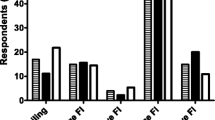Abstract
PURPOSE: Although fecal incontinence is a topic of considerable importance, there are no validated self-report measures of fecal incontinence available. The aim of this study was to develop a questionnaire to measure fecal incontinence and its risk factors in the community. METHOD: The reliability and concurrent validity of the fecal incontinence questionnaire were measured by test-retest procedures in a population of clinic patients. The questionnaire was created for a sixth-grade reading level, with large print. Ninety-four adult patients were surveyed. Thirty-four patients repeated the questionnaire through the mail. Forty-one patients were independently retested over the telephone by a physician to assess concurrent validity. Nine patients refused retest, and ten patients did not respond to a second contact. RESULTS: The fecal incontinence questionnaire was well understood and well accepted. Reliability (overall median kappa, 0.68; interquartile range, 0.03–1) and validity (overall median kappa, 0.59; interquartile range, 0.27–1) were acceptable for the mailed retest and the telephone retest, respectively. The presence of fecal incontinence as measured by questionnaire was greatly increased when compared with physician history in clinical records; only 3 percent of patients reported no fecal incontinence on the questionnaire when the clinic chart had documented this problem. CONCLUSION: Our initial results indicated that this new self-report questionnaire is a useful tool for assessing the presence of fecal incontinence in the population and has greater sensitivity compared with a standard physician interview. Specific attention should be given to identifying fecal incontinence and associated symptoms during history taking.
Similar content being viewed by others
References
Rao SS, Patel RS. How useful are manometric tests of anorectal function in the management of defecation disorders? Am J Gastroenterol 1977;92:469–75.
Campbell AJ, Reinken J, McCosh L. Incontinence in the elderly: prevalence and prognosis. Age Ageing 1985;14:65–70.
Tobin GW, Brocklehurst JC. Faecal incontinence in residential homes for the elderly: prevalence, aetiology and management. Age Ageing 1986;15:41–6.
Johanson JF, Lafferty J. Epidemiology of fecal incontinence: the silent affliction. Am J Gastroenterol 1996;91:33–6.
Thomas TM, Egan M, Walgrove A, Meade TW. The prevalence of faecal and double incontinence. Community Med 1984;6:216–20.
Enck P, Bielefeldt K, Rathmann W,et al. Epidemiology of faecal incontinence in selected patient groups. Int J Colorectal Dis 1991;6:143–6.
Kok AL, Voorhorst FJ, Burger CW,et al. Urinary and faecal incontinence in community-residing elderly women. Age Aging 1992;21:211–5.
Drossman DA, Li Z, Andruzzi E,et al. U.S. Householder survey of functional gastrointestinal disorders: prevalence, sociodemography, and health impact. Dig Dis Sci 1993;38:1569–80.
Nelson R, Norton N, Cautley E, Furner S. Communitybased prevalence of anal incontinence. JAMA 1995;274:559–61.
Talley NJ, O'Keefe EA, Zinsmeister AR, Melton JL III. Prevalence of gastrointestinal symptoms in the elderly: a population-based study. Gastroenterology 1992;102:895–901.
Borrie MJ, Davidson HA. Incontinence in institutions: costs and contributing factors. CMAJ 1992;147:322–8.
Talley NJ, Phillips SF, Melton LJ III, Wiltgen C, Zinsmeister AR. A patient questionnaire to identify bowel disease. Ann Intern Med 1989;111:671–4.
Locke GR, Talley NJ, Weaver AL, Zinsmeister AR. A new questionnaire for gastroesophageal reflux disease. Mayo Clin Proc 1994;69:539–47.
O'Keefe EA, Talley NJ, Tangalos EG, Zinsmeister AR. A bowel symptom questionnaire for the elderly. J Gerontol 1992;47:M116–21.
Barry MJ, Fowler FJ Jr, O'Leary MP,et al. The American Urological Association Symptom Index for benign prostatic hyperplasia. J Urology 1992;148:1549–57.
Leigh RJ, Turnberg LA. Faecal incontinence: the unvoiced symptom. Lancet 1982;1:1349–51.
Author information
Authors and Affiliations
Additional information
A copy of the complete questionnaire is available from Dr. Nicholas J. Talley.
About this article
Cite this article
Reilly, W.T., Talley, N.J., Pemberton, J.H. et al. Validation of a questionnaire to assess fecal incontinence and associated risk factors. Dis Colon Rectum 43, 146–153 (2000). https://doi.org/10.1007/BF02236971
Issue Date:
DOI: https://doi.org/10.1007/BF02236971




